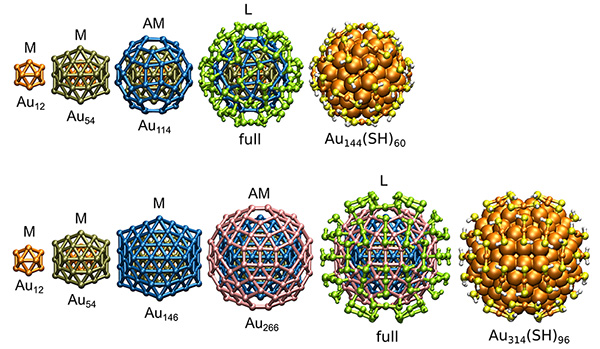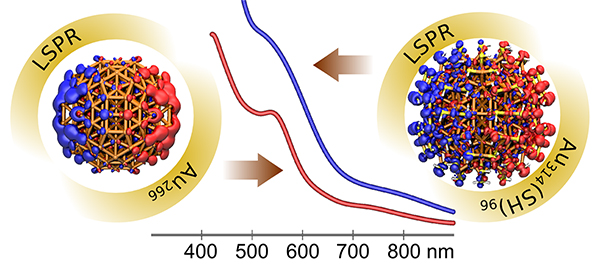MATERIALS SCIENCE AND CHEMISTRY
Project Plasmonic Ligand-Stabilized Gold Nanoclusters
Principal Investigator:
Hannu Häkkinen
Affiliation:
Nanoscience Center, University of Jyväskylä
Local Project ID:
PP12061117
HPC Platform used:
Hermit of HLRS
Date published:
Prof. Hannu Häkkinen (University of Jyväskylä, Finland) and his team are employing large-scale time-dependent density functional theory calculations to study absorption of light by 2-3 nm gold and alloyed gold-silver nanoclusters that are defined to the molecular precision, i.e., by exact composition and structure. The project aims at breakthroughs in microscopic understanding of the "birth of a plasmon" in nanoscale noble metal clusters.
This is of a wide scientific interest, since it will answer fundamental questions pertaining to transformation of nanoscale matter and nanoparticles from "molecular" to "metallic" regime with the concomitant change of optical response of the electrons from discrete transitions to collective behavior. This knowledge is important e.g. for designing and controlling plasmonic nanomaterials and nanosensors.
The nanoclusters that are studied in this project (with the atomicstic models shown in Figure 1) can be prepared in the laboratory by stabilizing gold nanoparticles by thiolate ligand molecules. This is a well-known synthetic route to produce air-stable, electrochemically and thermally stable cluster compounds with tunable sizes and properties in the nanometer scale. These cluster compounds constitute a class of very interesting novel nanomaterials that have been employed in a wide range of studies in molecular biology, inorganic chemistry, surface science and materials science with a wide range of potential applications in site-specific bioconjugate labelling, drug delivery and medical therapy, functionalisation of gold surfaces for sensing, molecular recognition and molecular electronics and nanoparticle catalysis.
The project contained a series of large-scale DFT (Density Functional Theory) and linear-response TDDFT (Time Dependent Density Functional Theory) computations, run on GCS supercomputer Hermit of HLRS Stuttgart. Specifically, gold and mixed gold-silver nanoclusters of 144 metal atoms and 60 ligand molecules were studied, as well as a model for a larger cluster of 314 and 96 ligand molecules. The size of the metal core is 1.5 nm and 2.0 nm for the smaller and larger clusters, respectively. A strong localized surface plasmon resonance (LSPR) develops at 540 nm (2.3 eV) in a gold cluster with a 2.0 nm metal core. The protecting molecular layer enhances the LSPR, while in a smaller gold cluster with 1.5 nm gold core, the plasmon-like resonance at 540 nm is confined in the metal core by the molecular layer.
The project contributed to understanding of the size limits for stable noble metal (gold and mixed gold-silver) nanoparticles that are important for the “birth” of the plasmonic behaviour. The results achieved shall help in establishing the lower-size limits of the plasmonic behavior of thiol-stabilized gold and gold-silver nanoclusters and will set a ground for further studies of ligand-effects on the plasmonic behavior as well as give benchmark results for further developments of more approximate calculation methods for optical excitations in large nanostructures.

Fig. 1. Atomistic models for the thiolate-stabilized gold nanoclusters studied in this PRACE-project. From ref. 1.
Copyright: University of Jyväskylä, Finland

Fig. 2. Strong absorption of light at around 540 nm (peaks in the absorption curves in the middle) by a metallic gold nanocluster consisting of 266 atoms (left) and as protected by a gold-thiolate layer (right) induces an oscillating electron density, visualized by red and blue areas. This excitation has a collective nature and can be called a surface plasmon.
Copyright: University of Jyväskylä, Finland
Computing Time on GCS system Hermit of HLRS Stuttgart was granted through the Partnership for Advanced Computing in Europe (PRACE).
Reference: S. Malola, L. Lehtovaara, J. Enkovaara, H. Häkkinen, "Birth of the localized surface plasmon resonance in monolayer-protected gold nanoclusters", ACS Nano 7, 10263 (2013).
Scientific Contact:
Prof. Hannu Häkkinen
Physics/Chemistry, Nanoscience Center
P.O. Box 35 (YFL), FIN-40014 University of Jyväskylä, Finland
e-mail: hannu.j.hakkinen@jyu.fi